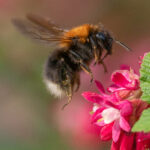How Can We Help?
 Like other types of bumblebees, tree bumblebees have a distinctive mating process. Here’s a general overview: one thing we would like to add is from our own experiences, we have found tree bumble bees a little more aggressive than some other species of bumble bees, so best to get them treated.
Like other types of bumblebees, tree bumblebees have a distinctive mating process. Here’s a general overview: one thing we would like to add is from our own experiences, we have found tree bumble bees a little more aggressive than some other species of bumble bees, so best to get them treated.
- Colony development: In spring, a mated queen overwintered in a safe location emerges from hibernation. She begins by finding a suitable place to start a new nest. Once she finds a good location, she starts laying eggs fertilized the previous year.
- Worker phase: The first batch of eggs develops into female worker bees. These workers take over foraging for food and expanding the nest, allowing the queen to focus on laying more eggs.
- Reproductive phase: As the season progresses, the queen starts laying eggs, developing into males (drones) and new queens. These eggs are larger and require more resources to develop. The drones and new queens are the reproductive members of the colony.
- Mating: Once the new queens and drones mature, they leave the nest to mate. The drones’ primary role is to mate with a new queen; after they have fulfilled this role, they typically die. The new queens mate with multiple drones to store enough sperm for a lifetime of egg-laying. This mating typically occurs in flight and often in designated areas known as “drone congregation areas.”
- Hibernation: After mating, the new queens feed heavily to build up fat reserves, then find a suitable place to hibernate through the winter. The rest of the original colony (including the old queen, workers, and any remaining drones) usually dies off as colder weather sets in.
- The cycle repeats: The following spring, the cycle begins again with the new queens emerging from hibernation to start their own colonies.
Remember, this process can vary slightly among different species of bumblebees, but this is the general pattern for many, including the tree bumblebee (Bombus hypnorum).
Please note if you have a tree bumble bee nest and its in a location where its dangerous to peoples and pets please give us a call to help you deal with them 01617769832 or click this link
